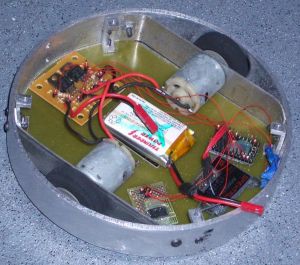Difference between revisions of "Melty Brain"
(Some added detail, still needs a lot of work) |
|||
| (2 intermediate revisions by 2 users not shown) | |||
| Line 1: | Line 1: | ||
| − | + | [[File:MeltyB.jpg|thumb|Melty Brain Beetleweight]] | |
The '''Melty Brain''' robot is a modified Thwack Bot that allows 100% of the bots mass to spin, but unlike a traditional Thwack bot that spins in place, the Melty Brain robot adjusts the wheel speed on each rotation allowing it to effectively drive around the arena. | The '''Melty Brain''' robot is a modified Thwack Bot that allows 100% of the bots mass to spin, but unlike a traditional Thwack bot that spins in place, the Melty Brain robot adjusts the wheel speed on each rotation allowing it to effectively drive around the arena. | ||
| Line 6: | Line 6: | ||
<br> | <br> | ||
| − | 2 wheeled robots: These melty brain robots have a more typical design with two wheels to balance the weight of the robot as it goes through it's rotation. Although these can be just as effective as 1-wheeled robots, the additional friction from the second wheel as well as weight-differences between the two wheels can make tuning the melty-brain more difficult. | + | 2 wheeled robots: These melty brain robots have a more typical design with two wheels to balance the weight of the robot as it goes through it's rotation. Although these can be just as effective as 1-wheeled robots, the additional friction from the second wheel as well as weight-differences between the two wheels can make tuning the melty-brain more difficult. One advantage of a two-wheeled Meltybrain robot is that it can revert to (more usual) tank-drive steering, e.g. to escape from corners. |
| − | <br> | + | <br><br> |
Mechanical Melty Brain: Although not a true Melty Brain, there have been examples where a small amount of weight is dedicated to a central 'directional' bot that maintains contact with the ground and uses a cam to adjust the wheel angle during the robots rotation. (Y-Pout) | Mechanical Melty Brain: Although not a true Melty Brain, there have been examples where a small amount of weight is dedicated to a central 'directional' bot that maintains contact with the ground and uses a cam to adjust the wheel angle during the robots rotation. (Y-Pout) | ||
| + | <br><br> | ||
| + | |||
| + | {{#ev:youtube|https://youtu.be/WMLEQafT7-Y}} | ||
| + | Rich Olson over at Nothing Labs has an open source melty brain project and has successfully used his approach with a variety of weight-classes. | ||
| + | http://www.nothinglabs.com/openmelt/ | ||
<br> | <br> | ||
| − | + | See also https://en.wikipedia.org/wiki/Translational_drift | |
Latest revision as of 03:07, 27 November 2021
The Melty Brain robot is a modified Thwack Bot that allows 100% of the bots mass to spin, but unlike a traditional Thwack bot that spins in place, the Melty Brain robot adjusts the wheel speed on each rotation allowing it to effectively drive around the arena.
1-wheeled robots: Although the design may seem counter-intuitive, there are advantages to using a single large motor to spin the robot. In addition to the increased power and durability of a single motor, tuning a single wheel to control the robots movement is generally easier.
2 wheeled robots: These melty brain robots have a more typical design with two wheels to balance the weight of the robot as it goes through it's rotation. Although these can be just as effective as 1-wheeled robots, the additional friction from the second wheel as well as weight-differences between the two wheels can make tuning the melty-brain more difficult. One advantage of a two-wheeled Meltybrain robot is that it can revert to (more usual) tank-drive steering, e.g. to escape from corners.
Mechanical Melty Brain: Although not a true Melty Brain, there have been examples where a small amount of weight is dedicated to a central 'directional' bot that maintains contact with the ground and uses a cam to adjust the wheel angle during the robots rotation. (Y-Pout)
Rich Olson over at Nothing Labs has an open source melty brain project and has successfully used his approach with a variety of weight-classes.
http://www.nothinglabs.com/openmelt/
